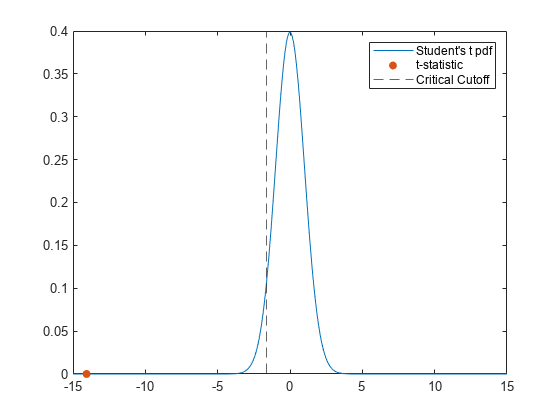ttest2
2 標本 t 検定
説明
h = ttest2(x,y,Name,Value)
例
データ セットを読み込みます。2 つの試験における学生の採点データを表すデータ行列の 1 列目と 2 列目を含むベクトルを作成します。
load examgrades
x = grades(:,1);
y = grades(:,2);2 つのデータ標本が、等しい平均の母集団から派生しているという帰無仮説を検定します。
[h,p,ci,stats] = ttest2(x,y)
h = 0
p = 0.9867
ci = 2×1
-1.9438
1.9771
stats = struct with fields:
tstat: 0.0167
df: 238
sd: 7.7084
h = 0 の戻り値は、ttest2 が既定の有意水準 5% で帰無仮説を棄却しないことを示します。
データ セットを読み込みます。2 つの試験における学生の採点データを表すデータ行列の 1 列目と 2 列目を含むベクトルを作成します。
load examgrades
x = grades(:,1);
y = grades(:,2);2 つのデータ ベクトルが等しい平均の母集団から派生しているという帰無仮説を、その母集団の分散も等しいと仮定せずに検定します。
[h,p] = ttest2(x,y,'Vartype','unequal')
h = 0
p = 0.9867
h = 0 の戻り値は、等しい分散が仮定されない場合であっても、ttest2 が既定の有意水準 5% で帰無仮説を棄却しないことを示します。
標本データを読み込みます。categorical ベクトルを作成し、車両の年式に従って車両の燃費データにラベルを付けます。
load carbig.mat; decade = categorical(Model_Year < 80,[true,false],["70s","80s"]);
年代ごとに燃費データの箱ひげ図を作成します。
boxchart(decade,MPG) xlabel("Decade") ylabel("Mileage")

年代ごとに燃費データからベクトルを作成します。左側 2 標本 "t" 検定を使用して、等しい平均の母集団からデータが派生しているという帰無仮説を検定します。1970 年代に製造された自動車の燃費の母集団平均は 1980 年代に製造された自動車の燃費の母集団平均よりも小さいという対立仮説を使用します。
MPG70s = MPG(decade == "70s"); MPG80s = MPG(decade == "80s"); [h,~,~,stats] = ttest2(MPG70s,MPG80s,"Tail","left")
h = 1
stats = struct with fields:
tstat: -14.0630
df: 396
sd: 6.3910
h = 1 の戻り値は、ttest2 が、1970 年代に製造された自動車の燃費の母集団平均は 1980 年代に製造された自動車の燃費の母集団平均よりも小さいという対立仮説を優先して、既定の有意水準 5% で帰無仮説を棄却したことを示します。
対応するスチューデントの "t" 分布、返された "t" 統計量、および棄却限界 "t" 値をプロットします。tinv を使用して、既定の信頼水準 95% における棄却限界 "t" 値を計算します。
nu = stats.df; k = linspace(-15,15,300); tdistpdf = tpdf(k,nu); tval = stats.tstat
tval = -14.0630
tvalpdf = tpdf(tval,nu); tcrit = -tinv(0.95,nu)
tcrit = -1.6487
plot(k,tdistpdf) hold on scatter(tval,tvalpdf,"filled") xline(tcrit,"--") legend(["Student's t pdf","t-statistic", ... "Critical Cutoff"])

オレンジ色のドットは "t" 統計量を表し、棄却限界 "t" 値を表す黒い破線の左側にあります。
入力引数
標本データ。ベクトル、行列または多次元配列として指定します。ttest2 は NaN 値を欠損データとして扱い、それらのデータを無視します。
xおよびyがベクトルとして指定されている場合、同じ長さにする必要はありません。xとyが行列として指定されている場合、これらの列数を同じにしなければなりません。この場合、ttest2は t 検定を各列で別個に実行し、結果のベクトルを返します。xとyが多次元配列として指定されている場合、それらのサイズは、大きさが 1 でない最初の次元を除くすべてに対して同じでなければなりません。
データ型: single | double
標本データ。ベクトル、行列または多次元配列として指定します。ttest2 は NaN 値を欠損データとして扱い、それらのデータを無視します。
xおよびyがベクトルとして指定されている場合、同じ長さにする必要はありません。xとyが行列として指定されている場合、これらの列数を同じにしなければなりません。この場合、ttest2は t 検定を各列で別個に実行し、結果のベクトルを返します。xとyが多次元配列として指定されている場合、それらのサイズは、大きさが 1 でない最初の次元を除くすべてに対して同じでなければなりません。ttest2は大きさが 1 でない最初の次元に対して機能します。
データ型: single | double
名前と値の引数
オプションの引数のペアを Name1=Value1,...,NameN=ValueN として指定します。ここで、Name は引数名で、Value は対応する値です。名前と値の引数は他の引数の後に指定しなければなりませんが、ペアの順序は重要ではありません。
R2021a より前では、名前と値をそれぞれコンマを使って区切り、Name を引用符で囲みます。
例: 'Tail','right','Alpha',0.01,'Vartype','unequal' は、有意水準 1% での右側検定を指定し、x と y の母集団分散は等しいと仮定しません。
仮説検定の有意水準。'Alpha' と、(0,1) の範囲内のスカラー値で構成されるコンマ区切りのペアとして指定します。
例: 'Alpha',0.01
データ型: single | double
平均を検定する入力行列の次元。'Dim' と正の整数値で構成されるコンマ区切りのペアとして指定します。たとえば、'Dim',1 を指定すると列の平均が検定され、'Dim',2 では行の平均が検定されます。
例: 'Dim',2
データ型: single | double
出力引数
1 または 0 として返される仮説検定の結果。
値が
1の場合、有意水準Alphaで帰無仮説が棄却されます。値が
0の場合、有意水準Alphaでは帰無仮説を棄却できません。
検定の p 値。[0,1] の範囲のスカラー値として返されます。p は、帰無仮説に基づく観測値と同様に、極端な検定統計量、またはより極端な検定統計量が観測される確率です。p の値が小さい場合、帰無仮説が有効でない可能性があります。
2 標本 t 検定の検定統計量。以下を含む構造体として返されます。
tstat— 検定統計量の値。df— 検定に対する自由度。sd— 母標準偏差のプールされた推定値 (等しい分散の場合) または母集団標準偏差のプールされていない推定値を含むベクトル (異なる分散の場合)。
詳細
2 標本 t 検定は、2 つの独立したデータ標本の位置パラメーターを比較するパラメトリック検定です。
検定統計量は次のようになります。
ここで、 と は標本平均、sx と sy は標本標準偏差、n と m は標本サイズです。
分散が等しい母集団から 2 つのデータ標本が派生していると仮定した場合、帰無仮説における検定統計量は自由度が n + m – 2 のスチューデントの t 分布になり、標本標準偏差はプールされた標準偏差で置き換えられます。
2 つのデータ標本は分散が等しい母集団から派生していると仮定しない場合、帰無仮説に基づく検定統計量には、サタースウェイトの近似によって与えられる自由度のスチューデント近似の t 分布が存在します。この検定は、ウェルチの t 検定と呼ばれる場合もあります。
多次元配列は、3 つ以上の次元をもつ配列です。たとえば、x が 1 x 3 x 4 の配列の場合、x は 3 次元配列です。
大きさが 1 でない最初の次元とは、配列の次元のうちサイズが 1 ではない最初の次元です。たとえば x が 1 x 2 x 3 x 4 の配列の場合、x の大きさが 1 でない最初の次元は 2 番目の次元です。
ヒント
sampsizepwrを使用して以下を計算します。指定された検出力およびパラメーター値に対応する標本サイズ
真のパラメーター値が与えられた場合に特定の標本サイズに対して達成される検出力
指定された標本サイズおよび検出力で検出できるパラメーター値
拡張機能
この関数は、GPU 配列を完全にサポートします。詳細は、GPU での MATLAB 関数の実行 (Parallel Computing Toolbox)を参照してください。
バージョン履歴
R2006a より前に導入
参考
ttest | ztest | sampsizepwr
MATLAB Command
You clicked a link that corresponds to this MATLAB command:
Run the command by entering it in the MATLAB Command Window. Web browsers do not support MATLAB commands.
Web サイトの選択
Web サイトを選択すると、翻訳されたコンテンツにアクセスし、地域のイベントやサービスを確認できます。現在の位置情報に基づき、次のサイトの選択を推奨します:
また、以下のリストから Web サイトを選択することもできます。
最適なサイトパフォーマンスの取得方法
中国のサイト (中国語または英語) を選択することで、最適なサイトパフォーマンスが得られます。その他の国の MathWorks のサイトは、お客様の地域からのアクセスが最適化されていません。
南北アメリカ
- América Latina (Español)
- Canada (English)
- United States (English)
ヨーロッパ
- Belgium (English)
- Denmark (English)
- Deutschland (Deutsch)
- España (Español)
- Finland (English)
- France (Français)
- Ireland (English)
- Italia (Italiano)
- Luxembourg (English)
- Netherlands (English)
- Norway (English)
- Österreich (Deutsch)
- Portugal (English)
- Sweden (English)
- Switzerland
- United Kingdom (English)